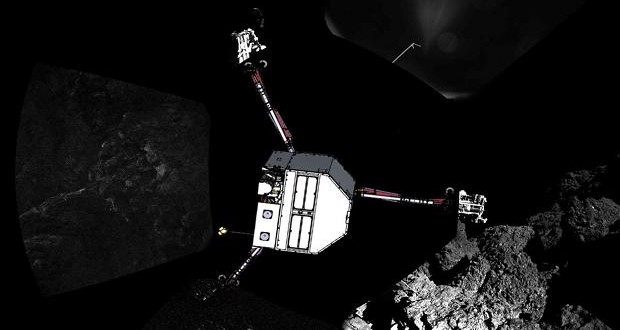The Philae comet lander has gone to sleep after running out of battery at the end of a historic mission that ended in triumph with a slew of data from the comet.
After nearly 57 hours on Comet 67P/Churyumov–Gerasimenko, the Rosetta mission’s Philae lander had completed its main science mission on November 15, 2014, when its batteries failed and the lander went silent. The Rosetta mothership was able to regain contact with Philae at 22:19 UTC (4:22 p.m. CST) Friday night (November 14). ESA says the signal was:
… initially intermittent, but quickly stabilized and remained very good until 00:36 UTC this morning [6:36 p.m. CST Friday evening].
In that last communication between the mothership and lander, Philae returned all its “housekeeping” data, as well as science data from targeted instruments. ESA said:
This completed the measurements planned for the final block of experiments on the surface.
The data returned from the comet’s surface will no doubt give scientists something to chew on for years.
The Rosetta mission made history on November 12 by sending the first-ever probe down to soft-land on the surface of a comet. That landing took place a few months after the Rosetta mothership became first spacecraft to rendezvous with – that is, begin moving side by side with – a comet, on August 6, 2014. The comet and spaceraft were more than 300 million miles (500 million km) away on November 12, when the Philae lander sent confirmation of its own successful touchdown on the surface of Comet 67P/Churyumov-Gerasimenko. There was some nail-biting when the lander initially failed to attach to the surface. However, as of Thursday morning, November 13, Philae appeared stable and was sending back data.
The lander set down not once, but three times, in the weak gravitational field of its comet. It essentially bounced in the comet’s weak gravity to two unintended landing sites. Its final touchdown was apparently not in a sunlit area, as planned, but in the shade of a cliff wall. The reduced sunlight meant its solar panels could not recharge the lander’s batteries as was originally hoped by mission planners. ESA said on November 15:
From now on, no contact would be possible unless sufficient sunlight falls on the solar panels to generate enough power to wake it up …
However, given the low recharge current available from the solar cells, it is considered unlikely that contact with Philae will be established in the coming days.
Agencies/Canadajournal
 Canada Journal – News of the World Articles and videos to bring you the biggest Canadian news stories from across the country every day
Canada Journal – News of the World Articles and videos to bring you the biggest Canadian news stories from across the country every day



